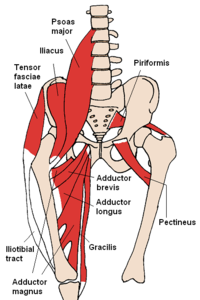
Photo from wikipedia
ObjectivesIntra-articular steroid injection (IASI) is an effective therapy for hip osteoarthritis (OA), but carries risks and provides significant pain relief to only two thirds of patients. We attempted to predict… Click to show full abstract
ObjectivesIntra-articular steroid injection (IASI) is an effective therapy for hip osteoarthritis (OA), but carries risks and provides significant pain relief to only two thirds of patients. We attempted to predict response to IASI in hip OA patients using baseline clinical, ultrasound, and MRI data.MethodsObservational study of 97 subjects with symptomatic hip OA presenting for IASI. At baseline and 8 weeks we obtained hip MRI, grayscale and Doppler ultrasound, clinical range of motion (ROM), timed-up and go test (TUG) scores, and self-reported Western Ontario and McMaster Universities Osteoarthritis (WOMAC) pain, stiffness, and function scores. Bone-capsule distance (BCD) measurements of inflammation on hip ultrasound and MRI were measured at three locations: the proximal-most uncovered portion of the femoral head, the superficial-most (apex) portion of the femoral head, and the largest fluid pocket at the femoral neck.ResultsUltrasound and MRI BCD correlated with each other significantly and strongly at the apex and neck. Power Doppler findings did not correlate significantly with any other imaging indices. Eight weeks post-injection, WOMAC pain, function, and stiffness scores significantly improved and TUG time improved nearly to the level of significance, but there were no significant changes in ultrasound, MRI, or Doppler indices. Baseline variables were not significantly different between responder and nonresponder WOMAC pain or TUG time cohorts.ConclusionBasic measures of inflammation on ultrasound and MRI are highly related to each other, but provide little insight into patient function and pain after IASI. Other mechanisms to explain improvement in patient status after IASI are likely at work.
Journal Title: Skeletal Radiology
Year Published: 2018
Link to full text (if available)
Share on Social Media: Sign Up to like & get
recommendations!